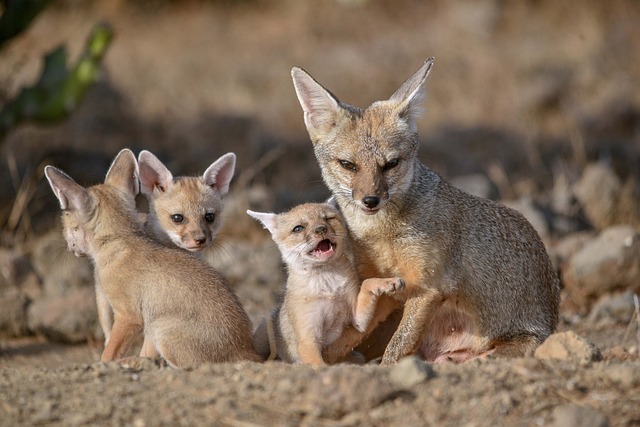The desert kit fox (Vulpes macrotis argypus) is a captivating and resilient species that thrives in the arid landscapes of North America. Known for its adaptability, agility, and remarkable survival skills, the desert kit fox has carved a niche for itself in some of the harshest environments on the continent.
Physical Characteristics:
The desert kit fox is a small canid, weighing between 2 to 4 pounds and measuring about 18 to 22 inches in length, excluding tail. Featuring their large ears, which can measure up to 4 inches across, the fox uses them to dissipate heat and enhance its hearing. The desert kit fox's fur ranges from sandy to grayish-brown, providing effective camouflage in its desert habitat.
Natural habitat:
The desert kit fox is found primarily in arid regions of North America, including the southwestern United States and northern Mexico. It is well adapted to a wide variety of habitats, from sandy desert to grasslands and scrub. These foxes are particularly adept at surviving in environments where water is scarce.
Behavior and diet:
Nocturnal by nature, the desert kit fox is most active during the cool hours of the night, and seeks refuge in underground dens during the scorching temperatures of the day. These dens, often former burrows of other animals, provide a safe haven from predators and extreme weather conditions.
The diet of the desert kit fox is diverse, including small mammals, birds, insects, and sometimes fruits and vegetation. Their ability to subsist on a variety of food sources allows them to adapt to fluctuations in prey availability.
Reproduction:
The breeding season of desert kit foxes usually occurs in the winter months. After a gestation period of approximately 50 days, the female gives birth to 3 to 7 pups. The family unit plays an important role in the survival of the offspring, as both parents actively participate in the care and protection of the children.
Conservation status:
While the desert kit fox is not currently listed as endangered, its population faces threats from habitat destruction, vehicle collisions, and diseases. Conservation efforts are vital to ensure the preservation of these adaptable canids and the delicate ecosystems they inhabit.
Conservation Measures:
Habitat Conservation: Conservation and protection of the desert kit fox's natural habitats is essential. This involves the establishment of wildlife corridors and protected areas to ensure the continued availability of suitable habitats.
Public awareness: Educating local communities about the importance of co-existing with desert kit foxes can reduce human-wildlife conflict. Awareness campaigns can encourage responsible pet ownership and discourage intentional feeding of foxes.
Research and monitoring: Continued research on the population dynamics, health, and behavior of desert kit foxes is important to develop effective conservation strategies. Monitoring changes in their habitats and promptly addressing emerging threats is critical to their long-term survival.
The desert kit fox stands as a testament to the incredible adaptability and resilience of wildlife in challenging environments. As stewards of the planet, it is our responsibility to appreciate and protect these fascinating creatures, ensuring that future generations can also marvel at the mysterious beauty of the desert kit fox. Through conservation efforts and responsible environmental practices, we can secure a sustainable future for both these foxes and the ecosystems they call home.
Kit fox facts
- Scientific Classification: The desert kit fox, scientifically known as Vulpes macrotis aresippus, belongs to the Canidae family.
- Habitat range: The desert kit fox is native to arid regions of North America, including the southwestern United States and northern Mexico.
Size and Appearance:
- Adult desert kit foxes typically weigh between 2 and 4 pounds.
- Excluding the tail, they are approximately 18 to 22 inches in length.
- In particular, their large ears, which measure up to 4 inches in length, aid in thermoregulation and enhance their hearing ability.
Night behavior:
- The desert kit fox is primarily nocturnal, displaying increased activity during the cooler hours of the night.
Dietary habits:
- The diet of the desert kit fox is diverse and includes small mammals, birds, insects, and sometimes fruits and vegetation.
- They are known for their adaptability to different food sources, allowing them to survive in a variety of environmental conditions.
Bill resident:
- Desert kit foxes are adept at building and using underground burrows as shelters. These burrows, often repurposed from other animals, serve as safe shelter from predators and extreme temperatures.
Adaptation to harsh environments:
- The color of their fur, ranging from sandy to grayish-brown, provides effective camouflage in desert environments.
- Large ears help dissipate heat, helping them cope with the high temperatures in their habitat.
conservation status:
- The desert kit fox is not currently listed as endangered, but the population faces threats from habitat destruction, vehicle collisions, and diseases.
Conservation Measures:
- Conservation efforts include habitat conservation, public awareness campaigns, and ongoing research to monitor and protect desert kit fox populations.
Life span:
- In the wild, desert kit foxes typically have a lifespan of 3 to 4 years. However, they can survive longer in captivity.
Communications:
- Desert kit foxes communicate through vocalizations including barks, yips, and howls. These sounds are often used to establish territory and communicate with family members.
Keystone species:
- Desert kit foxes play an important role in their ecosystems by controlling populations of small mammals and insects. Their presence contributes to maintaining the balance of the food web in arid environments.


Comments
Post a Comment